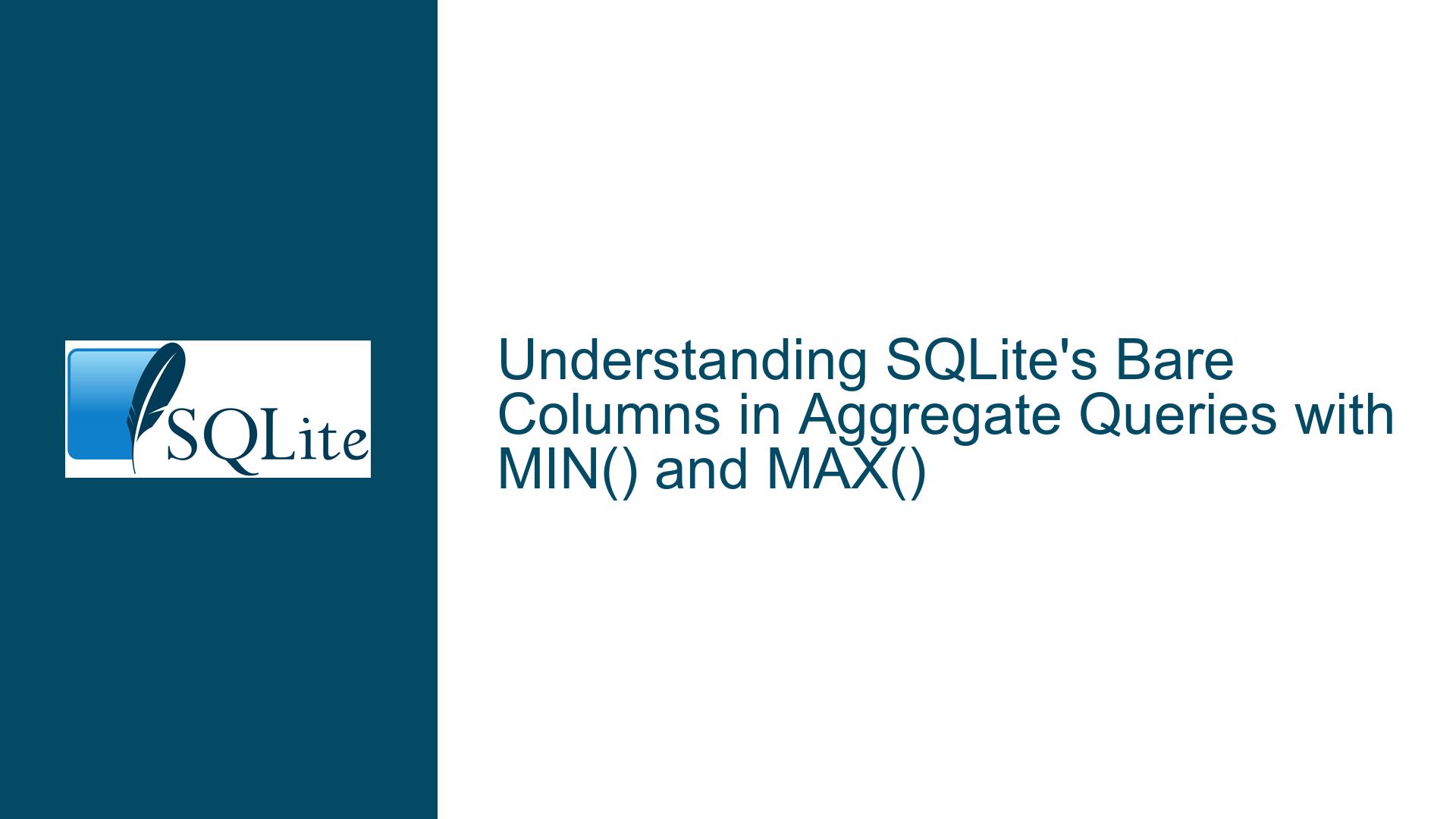SQLite’s Bare Columns in Aggregate Queries with MIN() and MAX()
SQLite’s Handling of Bare Columns in Aggregate Queries
SQLite exhibits a unique behavior when handling bare columns in aggregate queries, particularly when using the MIN() or MAX() functions. This behavior, while non-standard according to ANSI SQL, is well-documented and can be relied upon in specific scenarios. When an aggregate function like MIN() or MAX() is used in a SELECT statement, SQLite allows bare columns to appear in the result set without requiring them to be part of a GROUP BY clause or wrapped in an aggregate function. This behavior is particularly useful when you need to retrieve additional columns from the row that contains the minimum or maximum value of a specific column.
For example, consider the following table and query:
CREATE TABLE t (a INTEGER, b INTEGER);
INSERT INTO t VALUES (1, 10), (2, 20);
SELECT MIN(a), b FROM t;
In this case, SQLite returns the minimum value of column a (which is 1) and the corresponding value of column b from the same row (which is 10). This behavior is not permitted in standard SQL, as seen in databases like PostgreSQL, which would require column b to be included in a GROUP BY clause or wrapped in an aggregate function.
SQLite’s approach is documented under the "Side note: Bare columns in aggregate queries" section of the official documentation. It specifies that when a query contains exactly one aggregate function (MIN() or MAX()), SQLite will select the bare columns from any row that contains the aggregate value. If multiple rows contain the same aggregate value, SQLite is free to choose any of these rows, and the selection may depend on factors such as the query plan or the order in which rows are visited.
Ambiguity in Results Due to Non-Unique Aggregate Values
While SQLite’s handling of bare columns in aggregate queries is convenient, it introduces potential ambiguity when the aggregate value is not unique. For instance, consider the following table and query:
CREATE TABLE t (a INTEGER, b INTEGER);
INSERT INTO t VALUES (1, 10), (1, 15), (2, 20);
SELECT MIN(a), b FROM t;
In this case, there are two rows with the minimum value of a (both 1). SQLite will return one of these rows, but the choice of which row to return is not deterministic. The result could be either (1, 10) or (1, 15), depending on factors such as the query plan or the order in which rows are visited. This ambiguity can lead to inconsistent results, especially if the query plan changes due to operations like ANALYZE or VACUUM, or if the SQLite version is updated.
This behavior is particularly important to consider when designing queries that rely on the values of bare columns in conjunction with MIN() or MAX(). If the aggregate value is not unique, the results may vary unpredictably, which could lead to issues in applications that depend on consistent query results.
Ensuring Deterministic Results with GROUP BY and Subqueries
To avoid ambiguity and ensure deterministic results when using MIN() or MAX() with bare columns, you can use a GROUP BY clause or a subquery. These techniques provide more control over which rows are selected and ensure that the results are consistent across different executions of the query.
Using GROUP BY
One approach is to include the bare columns in a GROUP BY clause. This ensures that the query returns a single row for each group, and the bare columns are explicitly tied to the aggregate value. For example:
SELECT a, b FROM t GROUP BY a, b HAVING a = (SELECT MIN(a) FROM t);
In this query, the GROUP BY clause groups the rows by both a and b, and the HAVING clause filters the groups to include only those where a is equal to the minimum value of a. This approach ensures that the results are deterministic and consistent.
Using Subqueries
Another approach is to use a subquery to identify the row containing the minimum or maximum value and then join this result with the original table. For example:
SELECT t.a, t.b FROM t JOIN (SELECT MIN(a) AS min_a FROM t) AS sub ON t.a = sub.min_a;
In this query, the subquery calculates the minimum value of a, and the main query joins this result with the original table to retrieve the corresponding values of b. This approach also ensures deterministic results and provides greater flexibility in selecting additional columns or applying additional filters.
Comparison of Techniques
The following table compares the two techniques for ensuring deterministic results:
| Technique | Pros | Cons |
|---|---|---|
| GROUP BY | Simple and straightforward; ensures deterministic results | Requires explicit grouping of all bare columns; may be less efficient |
| Subquery | Provides greater flexibility; can handle complex filtering and joins | More verbose; may require additional indexing for optimal performance |
By using these techniques, you can avoid the ambiguity introduced by SQLite’s handling of bare columns in aggregate queries and ensure that your queries return consistent and reliable results.
In conclusion, SQLite’s handling of bare columns in aggregate queries with MIN() and MAX() is a powerful feature that can simplify query design in certain scenarios. However, it is essential to be aware of the potential for ambiguity when the aggregate value is not unique. By using GROUP BY clauses or subqueries, you can ensure deterministic results and avoid unexpected behavior in your applications.






